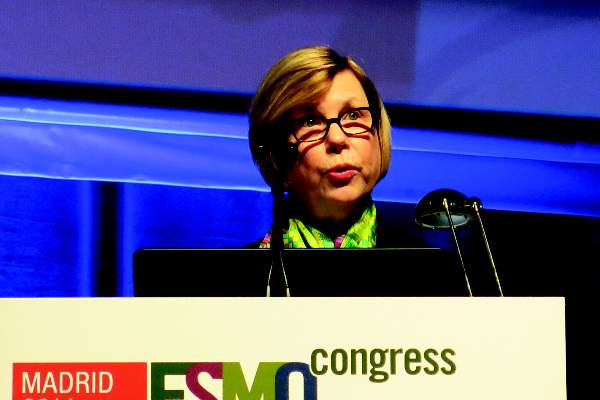User login
MADRID – First-line dual targeted therapy with pertuzumab and trastuzumab plus chemotherapy gives women with HER2-positive metastatic breast cancer an additional 15.7 months of life, according to the final overall survival analysis of the long-running CLEOPATRA trial.
After a median of 50 months follow-up, median overall survival was 40.8 months with trastuzumab (Herceptin) and docetaxel chemotherapy and 56.5 months with the addition of pertuzumab (Perjeta) (Hazard ratio, 0.68; P = .0002).
The benefit was consistent across all subgroups and did not come at the expense of added toxicities or long-term cardiac safety.
The 56.5-month survival advantage is unprecedented in this indication and sets a new standard of care, lead author Dr. Sandra Swain said during a presidential symposium at the European Society for Medical Oncology Congress.
Discussant Dr. Luca Gianni, with the San Raffaele Scientific Institute, in Milan, Italy, agreed, saying “CLEOPATRA is an unprecedented therapeutic success, with the unquestionable clinical implication that docetaxel, trastuzumab, and pertuzumab is the new standard, and not an option, for first-line treatment of HER2-positive metastatic breast cancer.”
In the first interim survival analysis from CLEOPATRA, there was a trend toward improved overall survival favoring pertuzumab, trastuzumab, and docetaxel.
The overall survival benefit reached statistical significance after a median follow-up of 30 months in the second interim analysis (Lancet Oncol. 2013;14:461-71) and was accompanied by a 6.3-month benefit in median progression-free survival (PFS) (18.7 months vs. 12.4 months).
The PFS gain was maintained with the longer follow-up (HR, 0.68; P less than .0001), indicating that PFS is a good surrogate for overall survival, noted Dr. Swain, medical director of the Washington Cancer Institute, Medstar Washington Hospital Center.
The phase III, double-blind trial randomized 808 women with HER2-positive metastatic, locally recurrent, or unresectable breast cancer to trastuzumab and at least six cycles of docetaxel chemotherapy with placebo or pertuzumab. The final survival analysis was planned after 385 reported deaths.
More than 70% of patients had visceral disease, roughly half were hormone receptor (HR) status positive and half HR negative, 53% had no prior neoadjuvant/adjuvant chemotherapy, and only about 10% had received prior trastuzumab. Their median age was 54 years.
During a press briefing on CLEOPATRA, Dr. Swain said the median survival with trastuzumab is already quite good at 40.8 months, but that the 15.6-month gain in overall survival with the addition of pertuzumab has not been seen before in this setting and is the kind of improvement oncologists hope for throughout their careers.
Cardiac safety was a concern with the two monoclonal antibodies, but there was only one new symptomatic heart failure in the pertuzumab group after 40 months and it resolved after treatment was stopped, she said. Rates of left ventricular ejection fraction (LVEF) decline to less than 50% and by at least 10% from baseline were also lower in the pertuzumab group than in the trastuzumab/docetaxel group (6.1% vs. 7.4%). LVEF declines were reversed in 88% of pertuzumab patients.
When asked whether both monoclonal antibodies are needed in the regimen, Dr. Swain said she would give her patients both.
Dr. Gianni observed that pertuzumab acts synergistically with trastuzumab and that neoadjuvant pertuzumab and trastuzumab plus chemotherapy improved complete responses in early breast cancer in the phase II NeoSphere trial he led (Lancet Oncol. 2012;13:25-32).
The phase III APHINITYtrial is also well underway in the adjuvant setting of HER2-positive disease, comparing pertuzumab, trastuzumab, and chemotherapy against trastuzumab and chemotherapy alone. If the results from CLEOPATRA in the metastatic setting are confirmed in APHINITY, it could provide a new standard of care in the adjuvant setting, he said.
Dr. Gianni said the CLEOPATRA results can be improved only by addressing key features of HER2-positive breast cancer linked to different sensitivity such as hormone receptor status, P1K3CA status, and the immune environment. NeoSphere and other studies have shown, for example, that estrogen- and progesterone-receptor positive, HER2-positive disease is less responsive to the treatment used in CLEOPATRA. The CLEOPATRA protocol, however, did not allow for endocrine therapy of patients with estrogen-receptor positive tumors, though dual blockade of HER2 with pertuzumab, trastuzumab, and concomitant endocrine therapy has been shown to be feasible and is actually being done in the adjuvant setting in APHINITY.
Thus, “The question is whether the addition of endocrine therapy after the end of chemotherapy in CLEOPATRA could have increased the already large benefit observed in women with HER2-positive, estrogen receptor-positive metastatic breast cancer,” he said.
MADRID – First-line dual targeted therapy with pertuzumab and trastuzumab plus chemotherapy gives women with HER2-positive metastatic breast cancer an additional 15.7 months of life, according to the final overall survival analysis of the long-running CLEOPATRA trial.
After a median of 50 months follow-up, median overall survival was 40.8 months with trastuzumab (Herceptin) and docetaxel chemotherapy and 56.5 months with the addition of pertuzumab (Perjeta) (Hazard ratio, 0.68; P = .0002).
The benefit was consistent across all subgroups and did not come at the expense of added toxicities or long-term cardiac safety.
The 56.5-month survival advantage is unprecedented in this indication and sets a new standard of care, lead author Dr. Sandra Swain said during a presidential symposium at the European Society for Medical Oncology Congress.
Discussant Dr. Luca Gianni, with the San Raffaele Scientific Institute, in Milan, Italy, agreed, saying “CLEOPATRA is an unprecedented therapeutic success, with the unquestionable clinical implication that docetaxel, trastuzumab, and pertuzumab is the new standard, and not an option, for first-line treatment of HER2-positive metastatic breast cancer.”
In the first interim survival analysis from CLEOPATRA, there was a trend toward improved overall survival favoring pertuzumab, trastuzumab, and docetaxel.
The overall survival benefit reached statistical significance after a median follow-up of 30 months in the second interim analysis (Lancet Oncol. 2013;14:461-71) and was accompanied by a 6.3-month benefit in median progression-free survival (PFS) (18.7 months vs. 12.4 months).
The PFS gain was maintained with the longer follow-up (HR, 0.68; P less than .0001), indicating that PFS is a good surrogate for overall survival, noted Dr. Swain, medical director of the Washington Cancer Institute, Medstar Washington Hospital Center.
The phase III, double-blind trial randomized 808 women with HER2-positive metastatic, locally recurrent, or unresectable breast cancer to trastuzumab and at least six cycles of docetaxel chemotherapy with placebo or pertuzumab. The final survival analysis was planned after 385 reported deaths.
More than 70% of patients had visceral disease, roughly half were hormone receptor (HR) status positive and half HR negative, 53% had no prior neoadjuvant/adjuvant chemotherapy, and only about 10% had received prior trastuzumab. Their median age was 54 years.
During a press briefing on CLEOPATRA, Dr. Swain said the median survival with trastuzumab is already quite good at 40.8 months, but that the 15.6-month gain in overall survival with the addition of pertuzumab has not been seen before in this setting and is the kind of improvement oncologists hope for throughout their careers.
Cardiac safety was a concern with the two monoclonal antibodies, but there was only one new symptomatic heart failure in the pertuzumab group after 40 months and it resolved after treatment was stopped, she said. Rates of left ventricular ejection fraction (LVEF) decline to less than 50% and by at least 10% from baseline were also lower in the pertuzumab group than in the trastuzumab/docetaxel group (6.1% vs. 7.4%). LVEF declines were reversed in 88% of pertuzumab patients.
When asked whether both monoclonal antibodies are needed in the regimen, Dr. Swain said she would give her patients both.
Dr. Gianni observed that pertuzumab acts synergistically with trastuzumab and that neoadjuvant pertuzumab and trastuzumab plus chemotherapy improved complete responses in early breast cancer in the phase II NeoSphere trial he led (Lancet Oncol. 2012;13:25-32).
The phase III APHINITYtrial is also well underway in the adjuvant setting of HER2-positive disease, comparing pertuzumab, trastuzumab, and chemotherapy against trastuzumab and chemotherapy alone. If the results from CLEOPATRA in the metastatic setting are confirmed in APHINITY, it could provide a new standard of care in the adjuvant setting, he said.
Dr. Gianni said the CLEOPATRA results can be improved only by addressing key features of HER2-positive breast cancer linked to different sensitivity such as hormone receptor status, P1K3CA status, and the immune environment. NeoSphere and other studies have shown, for example, that estrogen- and progesterone-receptor positive, HER2-positive disease is less responsive to the treatment used in CLEOPATRA. The CLEOPATRA protocol, however, did not allow for endocrine therapy of patients with estrogen-receptor positive tumors, though dual blockade of HER2 with pertuzumab, trastuzumab, and concomitant endocrine therapy has been shown to be feasible and is actually being done in the adjuvant setting in APHINITY.
Thus, “The question is whether the addition of endocrine therapy after the end of chemotherapy in CLEOPATRA could have increased the already large benefit observed in women with HER2-positive, estrogen receptor-positive metastatic breast cancer,” he said.
MADRID – First-line dual targeted therapy with pertuzumab and trastuzumab plus chemotherapy gives women with HER2-positive metastatic breast cancer an additional 15.7 months of life, according to the final overall survival analysis of the long-running CLEOPATRA trial.
After a median of 50 months follow-up, median overall survival was 40.8 months with trastuzumab (Herceptin) and docetaxel chemotherapy and 56.5 months with the addition of pertuzumab (Perjeta) (Hazard ratio, 0.68; P = .0002).
The benefit was consistent across all subgroups and did not come at the expense of added toxicities or long-term cardiac safety.
The 56.5-month survival advantage is unprecedented in this indication and sets a new standard of care, lead author Dr. Sandra Swain said during a presidential symposium at the European Society for Medical Oncology Congress.
Discussant Dr. Luca Gianni, with the San Raffaele Scientific Institute, in Milan, Italy, agreed, saying “CLEOPATRA is an unprecedented therapeutic success, with the unquestionable clinical implication that docetaxel, trastuzumab, and pertuzumab is the new standard, and not an option, for first-line treatment of HER2-positive metastatic breast cancer.”
In the first interim survival analysis from CLEOPATRA, there was a trend toward improved overall survival favoring pertuzumab, trastuzumab, and docetaxel.
The overall survival benefit reached statistical significance after a median follow-up of 30 months in the second interim analysis (Lancet Oncol. 2013;14:461-71) and was accompanied by a 6.3-month benefit in median progression-free survival (PFS) (18.7 months vs. 12.4 months).
The PFS gain was maintained with the longer follow-up (HR, 0.68; P less than .0001), indicating that PFS is a good surrogate for overall survival, noted Dr. Swain, medical director of the Washington Cancer Institute, Medstar Washington Hospital Center.
The phase III, double-blind trial randomized 808 women with HER2-positive metastatic, locally recurrent, or unresectable breast cancer to trastuzumab and at least six cycles of docetaxel chemotherapy with placebo or pertuzumab. The final survival analysis was planned after 385 reported deaths.
More than 70% of patients had visceral disease, roughly half were hormone receptor (HR) status positive and half HR negative, 53% had no prior neoadjuvant/adjuvant chemotherapy, and only about 10% had received prior trastuzumab. Their median age was 54 years.
During a press briefing on CLEOPATRA, Dr. Swain said the median survival with trastuzumab is already quite good at 40.8 months, but that the 15.6-month gain in overall survival with the addition of pertuzumab has not been seen before in this setting and is the kind of improvement oncologists hope for throughout their careers.
Cardiac safety was a concern with the two monoclonal antibodies, but there was only one new symptomatic heart failure in the pertuzumab group after 40 months and it resolved after treatment was stopped, she said. Rates of left ventricular ejection fraction (LVEF) decline to less than 50% and by at least 10% from baseline were also lower in the pertuzumab group than in the trastuzumab/docetaxel group (6.1% vs. 7.4%). LVEF declines were reversed in 88% of pertuzumab patients.
When asked whether both monoclonal antibodies are needed in the regimen, Dr. Swain said she would give her patients both.
Dr. Gianni observed that pertuzumab acts synergistically with trastuzumab and that neoadjuvant pertuzumab and trastuzumab plus chemotherapy improved complete responses in early breast cancer in the phase II NeoSphere trial he led (Lancet Oncol. 2012;13:25-32).
The phase III APHINITYtrial is also well underway in the adjuvant setting of HER2-positive disease, comparing pertuzumab, trastuzumab, and chemotherapy against trastuzumab and chemotherapy alone. If the results from CLEOPATRA in the metastatic setting are confirmed in APHINITY, it could provide a new standard of care in the adjuvant setting, he said.
Dr. Gianni said the CLEOPATRA results can be improved only by addressing key features of HER2-positive breast cancer linked to different sensitivity such as hormone receptor status, P1K3CA status, and the immune environment. NeoSphere and other studies have shown, for example, that estrogen- and progesterone-receptor positive, HER2-positive disease is less responsive to the treatment used in CLEOPATRA. The CLEOPATRA protocol, however, did not allow for endocrine therapy of patients with estrogen-receptor positive tumors, though dual blockade of HER2 with pertuzumab, trastuzumab, and concomitant endocrine therapy has been shown to be feasible and is actually being done in the adjuvant setting in APHINITY.
Thus, “The question is whether the addition of endocrine therapy after the end of chemotherapy in CLEOPATRA could have increased the already large benefit observed in women with HER2-positive, estrogen receptor-positive metastatic breast cancer,” he said.
AT ESMO 2014
Key clinical point: Pertuzumab, trastuzumab, and docetaxel chemotherapy is the new standard for first-line metastatic HER2-positive breast cancer.
Major finding: Median overall survival was 40.8 months with trastuzumab and chemotherapy and 56.5 months with the addition of pertuzumab.
Data source: Phase III trial in 808 women with metastatic HER2-positive breast cancer.
Disclosures: The study was funded by Hoffman-LaRoche and Genentech. Dr. Swain reported serving as an uncompensated consultant for Genentech/Roche.


